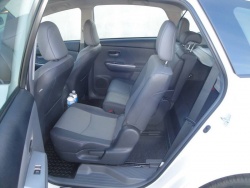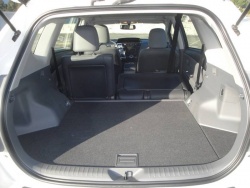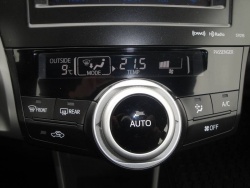 2012 Toyota Prius V. Click image to enlarge |
|
More Toyota Prius reviews at Autos.ca
Manufacturer’s web site |
Review and photos by Greg Wilson
Photo Gallery:
2012 Toyota Prius V
The new Toyota Prius wagon – oops, I mean the Prius V – is a new model for 2012, soon to be joined in the expanding Prius hybrid family by the Prius PHV (plug-in hybrid) and Prius c compact hatchback.
The “v” is for versatile, referring to the Prius V’s extra cargo-carrying utility and increased passenger space. However, we wonder why Toyota calls it the “Prius V” with a lower case ‘v’ when the badge on the car reads “PriusV”. Just asking…
Starting at $27,200, the 2012 Prius V is priced about $1,200 more than the 2012 Prius hatchback but is actually $600 cheaper than the 2011 Prius hatchback – Toyota has dropped the price of the Prius by $1,800 this year and added even more standard equipment.
The price of the Prius V seems even more reasonable when you consider that it has 50 per cent more interior volume than the Prius hatchback without sacrificing too much in the way of fuel economy and performance. Official fuel economy numbers for the Prius V are, City: 4.3 L/100 km (66 mpg Imp) and Hwy: 4.8 L/100 km (59 mpg Imp). That compares to the regular Prius with City: 3.7 L/100 km (76 mpg Imp) and Hwy: 4.0 L/100 km (71 mpg Imp).
 2012 Toyota Prius V. Click image to enlarge |
Undoubtedly, its real-world fuel consumption numbers are worse, but the official numbers are good for comparison purposes. A more accurate gauge of the Prius V’s fuel economy comes from the U.S. EPA which estimates 5.3/5.9 L/100 km city/hwy (53/48 mpg).
The Prius V has the same series-parallel hybrid powertrain as the regular Prius: a gas engine and electric motor that can operate together or separately depending on power requirements. The Prius’ 98-horsepower 1.8-litre DOHC 16-valve four-cylinder engine gas motor and 60-kW electric motor together produce 134 horsepower and drive the front wheels through a continuously variable transmission. There’s also a second electric motor to power electric features other than the drive wheels. A 201.6 volt nickel-metal hydride battery behind the rear seat provides the electricity.
The Prius V includes four driver-selectable drive modes: EV (battery power only at low speeds for up to a mile), Eco (reduced throttle input for better fuel efficiency), Power (increased mid-range throttle response), plus Normal, the default mode. An automatic stop/start system turns off the gas engine while stopped at traffic lights or when sitting in traffic.
 2012 Toyota Prius V. Click image to enlarge |
The Prius V’s fuel consumption is higher than the Prius hatch mainly because of its heavier curb weight. Weighing in at 1,485 kg (3,273 lbs), the Prius V is 105 kg (231 lbs) heavier.
It’s deceptively bigger too. Just looking at it, you wouldn’t guess that it’s 155 mm (6.0 in.) longer, 30 mm (1.2 in.) wider, 95 mm (3.7 in.) taller, with a wheelbase that’s been stretched by 80 mm (3.1 in.). Toyota calls it a mid-size crossover hybrid.
Interior impressions
The Prius V’s larger exterior dimensions and wagon-like roofline mean more passenger and cargo space: there’s about an inch more headroom for front and rear passengers (without the optional non-openable glass sunroofs which actually increase headroom), more front and rear hip and shoulder room, particularly in the rear seat, and more front legroom. Curiously, there are no big gains in rear legroom over the standard Prius, but perhaps that’s because it was already pretty generous and includes raised front seats that provide plenty of footroom.
     2012 Toyota Prius V. Click image to enlarge |
The cargo area benefits the most from its larger dimensions: the Prius V’s cargo capacity behind the rear seats is 58 per cent larger than the Prius hatchback (971 litres/34.3 cu. ft. vs 611 litres/21.6 cu. ft.). As well, both rear seats in the Prius V can slide forwards, allowing up to 1,138 litres (40.2 cu. ft.) of cargo space behind the rear seats. With both rear seatbacks folded flat, the total cargo area in the Prius V amounts to 1,905 litres (67.3 cu. ft.). That’s more than the maximum cargo capacity of the VW Golf Wagon TDI or Ford Escape Hybrid. The cargo area includes a sliding privacy cover, and underneath the floor are some hidden storage bins about 15 cm deep and a metre wide.
The Prius V’s instrument panel is different from the standard Prius’. Rather than a high centre console that flows into a curving instrument panel, the Prius V has a separate centre console and instrument panel and the wand-like shift lever has been moved to the dash near the steering wheel. The climate controls have been redesigned with a new central control dial, and the touch-screen controls have been made simpler with fewer buttons. At the bottom of the centre stack, the open storage bin has been made more accessible and is close to a 12 volt powerpoint and USB and auxiliary ports for audio devices.
The digital instruments are centrally positioned on top of the dash under a hood which shields them from glare. From left to right, the display includes a Charge/Power readout which moves upwards when accelerating and downwards when the battery is being recharged while coasting or decelerating; next to that is an EV light which illuminates when the vehicle is running on battery power alone; to the right of that is the gear selector indicator, the gasoline fuel gauge, the battery charge level, a trip computer showing average fuel economy and other information, an odometer, and a digital clock.
The Prius V’s standard 6.1-inch centre touch-screen located in the middle of the dash can be used to select audio channels, telephone, and car information, but not climate control functions. The touch-screen is easy to use but can be difficult to see when glare obscures the screen. Surrounding the screen are dials for Volume and Tune as well as buttons for Seek, Track, Audio, Telephone, Car (info), Setup, and the first time I’ve seen it, Apps. Plug-in your smart phone, and scroll through your apps!
The Setup button shows trip info such as average speed, current fuel economy, history of previous fuel economy, while a subscreen shows a graphic of the car’s powertrain with real-time power distribution between the gas engine, electric motor, battery and drive wheels.
The climate control has a large dial which, when pushed sideways, acts as a controller for moving the display between ventilation selection, temperature selection, and fan speed. Rotating the dial then varies the temperature, adjusts the fan speed and or selects a vent mode. It’s similar to using a computer mouse.
Below the heater is a large open bin where you can hook up your phone or other electrical device to 12 volt power outlet, USB port, or auxiliary port. The large bin will hold up to 23 compact discs. Buttons for the front seat heaters are also there, but are difficult to see from the driver’s seat – and each heater has only one temperature setting.











